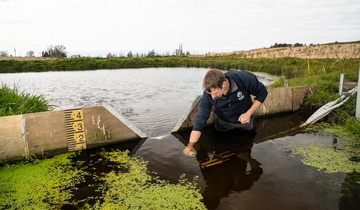How may agricultural activities increase sediments in waterways?
When soils erode, sediments are washed into streams and rivers. Sediments in waterways are often high in areas where river banks are grazed by livestock, on farms with steep slopes cleared of trees, and where there is a lack of riparian vegetation.
Grazing along river banks removes or damages existing vegetation, increases compaction of the soil, and damages the banks of a waterway. In time, the area around a stream will become unstable, prone to slips, and vulnerable to erosion, especially during floods.
Deer can cause high sediment loads into waterways because they have a tendency to walk along fence lines. This activity causes soil compaction and erosion and may lead to the formation of drainage channels that then transport water and sediment to the nearest stream. The natural behaviour of deer (they like to wallow in wetlands and small streams), particularly in confined farming situations, makes it harder to manage water quality.
Potential impacts of sediment on water quality and mahinga kai
- Decreased water clarity - increased sediment loading in a stream will decrease water clarity and reduce visibility, making it harder for fish to find food and places to live.
- Damage to fish gills and filter feeding apparatus of invertebrates.
- Changes to the benthic (bottom) structure of the stream/river bed - coarse substrates such as gravels and boulders are replaced/smothered by sand and silt.
- Decreased numbers of invertebrate species from smothering of habitat - invertebrates are a food source to some mahinga kai (e.g., kōura and fish) and diverse invertebrate communities are also an indicator of healthy stream systems.
- Decreased algal food supply at base of food chain - sediments can scour algae from rocks, make algae unpalatable, or reduce light to levels where algae cannot grow (because plants need light to photosynthesise).
- Increased contaminants from surrounding land - sediments can transport attached pollutants such as nutrients, bacteria, and toxic chemicals from agriculture and horticulture into our streams.






